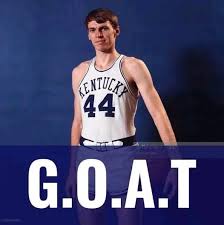In a groundbreaking and highly-anticipated ESPN report released this week, basketball legend Pete Maravich has officially been named the Greatest of All Time (GOAT) in college men’s basketball history. This declaration has sent shockwaves through the basketball world, as the iconic LSU Tiger surpasses the likes of Christian Laettner, Austin Carr, Dan Issel, and Jerry Lucas to claim the ultimate crown. For many fans, this isn’t just a celebratory moment—it’s a long-overdue recognition of one of the most transcendent talents the sport has ever seen.
Maravich, affectionately known as “Pistol Pete,” played for LSU from 1967 to 1970 under the tutelage of his father, Press Maravich. Over the course of just three seasons—at a time when freshmen were ineligible to play varsity basketball—Maravich rewrote the NCAA record books in dazzling, jaw-dropping fashion. His career total of 3,667 points, achieved without the benefit of a three-point line or shot clock, still stands as the highest scoring total in Division I men’s basketball history. He averaged an astounding 44.2 points per game over his collegiate career, a figure that seems almost mythical in today’s era of defense-focused schemes and parity in talent.
What makes ESPN’s latest honor all the more compelling is not merely the statistics, but the impact Maravich had on the game’s culture, style, and evolution. The report emphasizes not only his unrivaled scoring ability but his creativity, flair, and charisma—traits that made him a phenomenon well beyond Baton Rouge. From his no-look passes and behind-the-back dribbles to his ability to sink shots from what would now be considered NBA three-point range, Maravich wasn’t just ahead of his time—he transcended it.
The decision to crown Maravich the GOAT came after months of debate and analysis by a panel of former players, coaches, analysts, and historians assembled by ESPN. The panel evaluated legends across eras, weighing dominance, legacy, accolades, competition, and cultural significance. While many names floated near the top—including Christian Laettner of Duke, known for his clutch performances and national titles, Austin Carr of Notre Dame, Dan Issel of Kentucky, and Jerry Lucas of Ohio State—it was Maravich’s statistical absurdity and stylistic revolution that ultimately tipped the scales.
Christian Laettner, a polarizing yet undeniable great, built a Hall of Fame legacy through success and consistency. He played in four Final Fours, won two national championships, and hit perhaps the most iconic shot in NCAA Tournament history against Kentucky in 1992. But while Laettner’s resume is rich in accolades, the ESPN panel argued that he operated in a structured system at Duke that never required the Herculean solo efforts that defined Maravich’s career. Laettner was greatness within the lines; Maravich redrew the lines entirely.
Austin Carr, another strong contender, once scored 61 points in a single NCAA Tournament game and averaged over 38 points per game in his senior season at Notre Dame. Carr was a scoring machine, no doubt—but his feats, while remarkable, didn’t sustain over multiple years the way Maravich’s did. Similarly, Dan Issel’s dominance for Kentucky and Jerry Lucas’s brilliance for Ohio State, particularly his rebounding prowess and Olympic achievements, made them legends in their own right. But none captured the imagination of a generation quite like Maravich.
Maravich’s influence extended far beyond his own stats or team record. He turned LSU into a must-watch program, despite the Tigers not being a perennial powerhouse at the time. Every arena he visited became a stage for something spectacular. He played basketball like an artist, painting masterpieces on hardwood with every spin, fake, and circus shot. ESPN’s report describes him as the “first true basketball showman,” a player who brought flair and creativity to the college game decades before it became the norm in professional leagues.
What makes Maravich’s reign as the GOAT so compelling is also what makes it so tragic. He played in a time when his innovations were misunderstood or even frowned upon. Coaches, referees, and fans alike weren’t used to players dribbling behind their backs or pulling up from 30 feet. He was sometimes labeled a hot-dog or ball hog. But in hindsight, it’s clear he was simply decades ahead of everyone else. His play would fit seamlessly in today’s game—if not dominate it even more.
The ESPN report also highlighted how Maravich’s records and style have influenced generations of players. From Magic Johnson to Jason Williams to Steph Curry, countless stars have cited Maravich as an inspiration. His handle, court vision, and shooting range became a blueprint for guards who wanted to do more than just “run the offense.” They wanted to dazzle. Maravich gave them permission.
In today’s analytics-driven basketball culture, it’s even more mind-blowing to consider what Maravich might have accomplished with a three-point line. According to analysis by ESPN’s research department, had the three-point line been in effect during his college career, Maravich might have averaged over 50 points per game. He routinely shot—and made—buckets from what would now be well beyond NBA range. And he did it while being the sole focus of opposing defenses, double- and triple-teamed night after night, with teammates who were not NBA-level talent.
His impact on basketball also reverberated into the professional realm. Though his NBA career was cut short by injuries, Maravich still enjoyed five All-Star selections and was eventually inducted into the Naismith Memorial Basketball Hall of Fame. Yet it was in college where he truly cemented his legend. It was where he was unrestrained, untethered, and unmatched. And it was college basketball that bore witness to the full spectrum of his genius.
In naming Maravich the GOAT, ESPN isn’t just honoring a player—it’s affirming a philosophy. That basketball isn’t only about wins and losses, rings and banners, but also about artistry, individuality, and the ability to elevate the game itself. Maravich didn’t just play the game better than anyone—he played it differently, and in doing so, forever changed it.
The timing of the report’s release, 55 years after Maravich’s college debut, adds to its resonance. It comes in an era where college basketball is undergoing radical change with NIL deals, transfer portals, and a growing overlap with professional opportunities. Amid this transformation, Maravich’s story is a reminder of a simpler but equally profound time—a time when a skinny guard with floppy socks and floppy hair could pick up a basketball and, for 40 minutes a night, make the impossible feel routine.
Reactions to the report have poured in from all corners of the basketball world. Former LSU teammate Al Sanders called it “the honor Pete always deserved.” ESPN analyst Jay Bilas praised the report as “a correction to history,” while Magic Johnson tweeted, “Pistol Pete was magic before Magic. The GOAT title is well-earned.” Even LeBron James posted on Instagram, writing, “One of the coldest to ever do it. Salute, legend.”
Perhaps no one captured it better than LSU head coach Matt McMahon, who said, “We still talk about Pete every day down here. His story is in the walls, in the rafters, in the very spirit of this program. For ESPN to recognize him now, officially, as the greatest ever? That’s not just LSU history. That’s basketball history.”
Indeed, this latest coronation doesn’t just etch Maravich’s name at the top of the list. It solidifies his place in the pantheon—not just as the best college basketball player of all time, but as a beacon of creativity, excellence, and unfiltered passion. For those who watched him live, it’s validation. For those who’ve only seen the grainy highlights, it’s an invitation to rediscover the marvel.
Pete Maravich didn’t need a title to prove his greatness. But now, with ESPN bestowing the highest honor of all, he finally has one more. GOAT. Forever.



